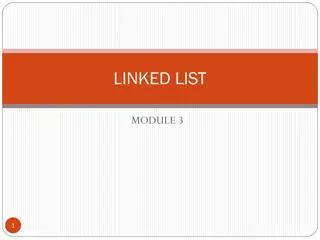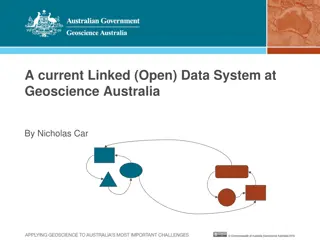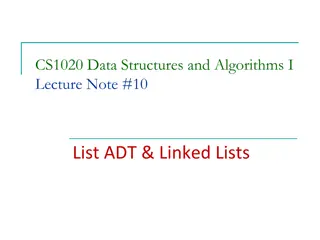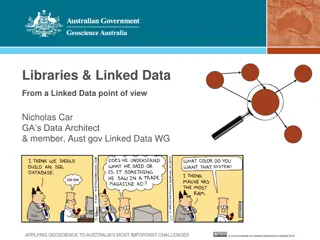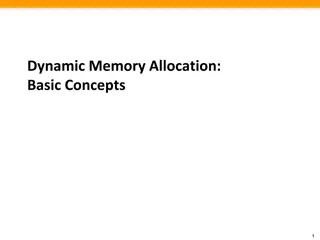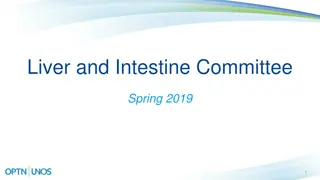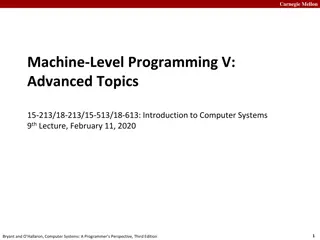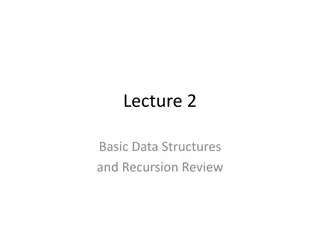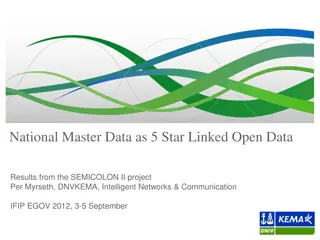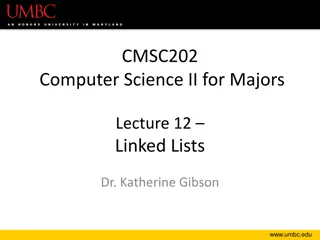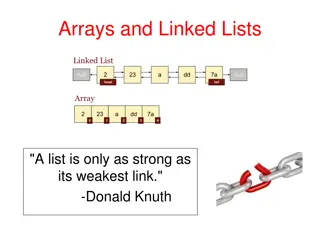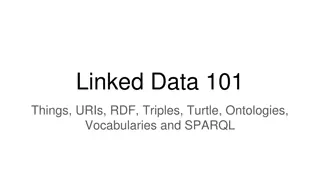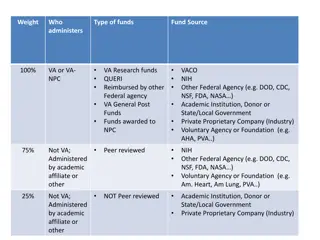Java Allocation and C2
Java object allocation and escape analysis play crucial roles in memory management and performance optimization within the Java Virtual Machine (JVM). This comprehensive overview covers topics such as object vs. scalar allocation, object allocation mechanisms, hotspot escape analysis, ideal and conn
2 views • 22 slides
LINKED LIST.MODULE 3
Explore the concept of linked lists, a linear collection of data elements represented as nodes with information and addresses to the next node. Learn about implementations, traversing, and searching algorithms in linked lists with detailed explanations and visuals.
1 views • 41 slides
Understanding File Allocation Strategies in Operating Systems
Explore various file allocation schemes like extent-based systems, linked allocation, file allocation table (FAT), indexed allocation, and combined schemes used in operating systems. Learn about their pros and cons, including details on maximum file size calculations based on disk block sizes and po
0 views • 20 slides
Operating System: File Allocation Methods
File allocation methods in operating systems determine how files are stored in disk blocks. The main methods include Contiguous Allocation, Linked Allocation, and Indexed Allocation. Contiguous Allocation involves allocating blocks in a contiguous manner for efficient disk space utilization and fast
0 views • 14 slides
Proposed Changes to Forward Capacity Cost Allocation
The document discusses proposed changes to the allocation of forward capacity costs effective June 1, 2020. It highlights the need for transparency in cost allocation, focusing on zonal demand curves and the Marginal-Reliability Impact. The current opaque method is critiqued for potential non-intuit
0 views • 47 slides
Understanding Sex-Linked Inheritance: Key Concepts and Examples
Sex-linked inheritance refers to the transmission of genetic traits determined by genes located on the sex chromosomes. This type of inheritance differs from autosomal inheritance due to the unique characteristics of the X and Y chromosomes. In organisms with XX/XY sex determination, genes on the X
1 views • 21 slides
Designing 9-Bit RU Allocation Subfield for EHT Trigger Frame in IEEE 802.11-20
IEEE 802.11-20/1845r2 presents a proposal for enhancing the RU allocation subfield design in the EHT Trigger frame to accommodate bandwidth support up to 320MHz and multiple RU or MRU allocations for UL MU transmissions in the 11be standard. The modification addresses inconsistencies in MRU mapping
0 views • 34 slides
Risk Allocation for Allocation Wells in Energy Law
Definition of allocation wells in energy law, advantages and disadvantages, lessees' rights, allocation of production to mineral owners, and legal cases related to pooling agreements. The content discusses various aspects of risk allocation for unagreed horizontal wells and the importance of clear a
0 views • 16 slides
Understanding Sex-Linked Inheritance in Genetics
Explore the concept of sex-linked inheritance, where traits are determined by genes on sex chromosomes. Learn about X-linked and Y-linked characteristics, the patterns of inheritance in males and females, and examples of sex-linked traits like Hemophilia and Color blindness. Understand the implicati
1 views • 24 slides
Pennsylvania's Agriculture-Linked Investment Program Overview
The Agriculture-Linked Investment Program (AgriLink Program) in Pennsylvania offers low-interest loans up to $25 million to assist farmers in implementing best management practices. The program provides benefits like a subsidized interest rate reduction for construction projects and is funded throug
2 views • 22 slides
Understanding Doubly Linked Lists in C Programming
A doubly linked list in C comprises nodes with pointers to the next and previous nodes. Managing two sets of pointers can be complex, but adds flexibility for adding and removing nodes dynamically. This post explores the structure, implementation, and examples of doubly linked lists in C.
0 views • 13 slides
Spatial Stream Allocation in IEEE 802.11-20 Trigger Frames
The document discusses spatial stream allocation in IEEE 802.11-20 trigger frames, specifically focusing on the SS Allocation subfield. It explains how trigger frames allocate resources for TB PPDU transmissions and solicit User Info fields, detailing the RU Allocation and SS Allocation subfields. T
3 views • 15 slides
Uncovering Business Models for Linked Government Data
Delve into the exploration of business models for linked government data through a comprehensive study under the European Commission's ISA Programme. Discover key stakeholders, methodologies like the Business Model Canvas, case studies, and the potential value of Linked Open Government Data. Uncover
0 views • 19 slides
Introduction to Linked Data in Geoscience Australia
Linked Data is a publishing paradigm that elevates both web pages and data to first-class citizens of the Web, enabling a global data space evolution. This concept, as explored in Geoscience Australia, involves the utilization of Semantic Web standards to promote common data formats and exchange pro
1 views • 23 slides
Enhancing Heart-Lung Allocation Policy for Organ Transplantation
This project focuses on improving the allocation of heart-lung blocks for organ transplantation by providing clear guidelines to Organ Procurement Organizations (OPOs). The goal is to ensure consistent practices among OPOs across the country, promoting fairness and efficiency in organ allocation. Th
0 views • 11 slides
Understanding List ADT and Linked Lists
This content emphasizes on the List ADT and Linked Lists in the context of data structures and algorithms. It covers the definition of List ADT, implementations using arrays and linked lists, Java API LinkedList class usage, and various types of linked lists such as BasicLinkedList, EnhancedLinkedLi
0 views • 82 slides
Understanding Linked Data: Building a Semantic Web Ecosystem
Explore the world of Linked Data from the perspective of Nicholas Car, a data architect and member of Aust.gov Linked Data WG. Uncover the significance of Linked Data, its role in evolving the web into a global data space, and the Australian Govt. Linked Data Working Group's initiatives. Dive into i
0 views • 47 slides
Understanding X-Linked Inheritance and Diseases
X-linked inheritance involves genes on the X chromosome, leading to unique inheritance patterns and characteristics. X-linked diseases vary in expression between males and females due to differences in chromosome composition. X-linked dominant traits are rare but can have significant impacts on affe
1 views • 21 slides
Introduction to Linked Lists: An Overview of LinkedIntList
This lesson delves into Linked Lists by introducing the LinkedIntList and its implementation with a chain of linked nodes. Understanding the concept of LinkedIntList, its methods like add, get, indexOf, remove, size, and toString, as well as how it maintains references to its front, is crucial. Thro
0 views • 44 slides
Understanding Dynamic Memory Allocation in Programming
Dynamic memory allocation is a crucial concept in programming where programmers use allocators like malloc to acquire memory at runtime for data structures. This process involves managing the heap, maintaining variable-sized blocks, and utilizing functions like malloc, free, calloc, realloc, and sbr
0 views • 33 slides
Update in Liver and Intestine Allocation Policies for Spring 2019
The recent updates in liver and intestine allocation policies for Spring 2019 include eliminating region and DSA from the allocation model, prioritizing medical urgency and proximity, enhancing pediatric candidate considerations, and adjusting weights for DCD and elderly donors. Acuity Circles Alloc
0 views • 15 slides
Understanding Linked Genes and Genetic Mapping in Inheritance
Linked genes inherited together on chromosomes influence genetic traits. Discover the differences between sex-linked and linked genes, the concept of crossing over, linkage mapping, and the significance of gene distance in recombination. Explore the work of Alfred Sturtevant in gene mapping through
1 views • 21 slides
Changes in Capacity Allocation Regulations for Gas Infrastructures in Portugal
The new regulation in Portugal brings significant changes in capacity booking and trading to promote convergence with CAM NC and enable a secondary market. Major changes include ex-ante payment of capacity rights, capacity allocation via a booking platform, and enhancement of liquidity in the second
0 views • 13 slides
Understanding Memory Layout and Allocation in Computer Systems at Carnegie Mellon University
Exploring the memory layout and allocation in computer systems through lectures at Carnegie Mellon University, focusing on topics such as buffer overflow vulnerability protection, unions, shared libraries, stack, heap, data locations, addresses, and practical memory allocation examples. The content
1 views • 55 slides
Effective Allocation Strategies for Decision-Making
Explore various allocation strategies such as Majority Rule, Random Selection, Authority, and Competition through a scenario of deciding who gets the candy. Analyze the efficiency and fairness of each strategy, consider the balance between economic efficiency and equity, and envision potential impac
0 views • 8 slides
Comparison between Array and Linked List Data Structures
Linked lists and arrays are commonly used data structures in programming. Linked lists offer flexibility in size changes and efficient rearrangement of elements, while arrays provide direct access to elements based on their index. Linked lists involve pointers connecting elements, allowing for dynam
0 views • 24 slides
Understanding Linked Lists in Data Structures and Algorithms
Linked lists are dynamic data structures where memory can be allocated and varied during usage. They consist of nodes with data and links pointing to subsequent elements. Single, circular, and double linked lists are common types. Representation can be static using arrays or dynamic using memory man
0 views • 8 slides
Understanding Basic Data Structures and Recursion in Programming
Explore basic data structures and recursion in programming through a series of lectures covering abstract data types, list operations, array characteristics, linked lists, doubly linked lists, and circular linked lists. Dive into concepts such as array indexing, resizing, and various list implementa
0 views • 92 slides
Improving Interoperability with Linked Open Data in the SEMICOLON II Project
The SEMICOLON II project aimed to enhance eGov solutions by utilizing Linked Open Data principles to open up public registers and create semantic technologies. The project spanned from 2007 to 2013 with a budget of approximately $15 million, focusing on core national master data maintenance and moti
0 views • 25 slides
Understanding Linked Lists in Computer Science
Explore the concept of linked lists in computer science, detailing their structure, advantages, and disadvantages compared to vectors. Learn about the representation in memory, node structure, and reasons for using linked lists over other data structures.
0 views • 36 slides
Inserting a Number into a Sorted List Using Linked Lists
Implementing the task of inserting a new number into a sorted list of numbers efficiently using linked lists. The solution involves creating a linked structure where nodes are linked together in linear order, allowing for constant time operations. By utilizing linked lists, the insertion process can
0 views • 15 slides
Understanding Arrays and Linked Lists in Computer Science
Arrays and linked lists are fundamental data structures in computer science. Arrays provide a fixed-size collection, while linked lists offer dynamic sizing. Arrays are efficient for accessing elements but can be inefficient for insertions and deletions. Linked lists, on the other hand, allow for ea
0 views • 42 slides
Optimization of Heart-Lung Allocation Policy for Organ Procurement Organizations (OPOs)
This document provides guidance to Organ Procurement Organizations (OPOs) regarding the allocation of heart-lung blocks, focusing on resolving issues related to Policy 6.5.E. The aim is to establish clear policies and principles to ensure consistent allocation practices among OPOs nationwide. Throug
0 views • 11 slides
Understanding Linked Data: Basics to Publishing and Beyond
Delve into the world of Linked Data with topics ranging from its fundamental principles like URIs, RDF, and Triples to practical aspects like publishing data using standard web technologies such as HTTP. Explore the essence of RDF graphs, the significance of naming things with URLs, and ways to prov
0 views • 26 slides
The System for Transparent Allocation of Resources (STAR) Overview
STAR is a framework implemented by GEF to allocate resources among biodiversity, climate change, and land degradation focal areas. It updates the Resource Allocation Framework to maximize impact, promote environmental policies, and meet country priorities through a structured allocation process. The
0 views • 26 slides
E-GRANT: Resource Allocation Tool Features and Development
E-GRANT is an advanced resource allocation tool developed by EGI-Engage for efficiently managing resources allocation for projects related to computing, storage, and VMs. The tool allows customers to send requests, negotiate resources, sign SLAs, and view allocations. It also enables resources provi
0 views • 5 slides
Challenges of Flow Rate Fairness in Network Resource Allocation
Addressing the concept of flow rate fairness in network resource allocation, this content explores its limitations and challenges. Despite being a goal in protocols like TCP, the practicality and enforceability of flow rate fairness are questioned. It highlights the inadequacy of flow rate as a meas
0 views • 15 slides
Soft Resource Allocation in N-Tier Application Scalability
This research paper explores the impact of soft resource allocation on n-tier application scalability, discussing topics such as over-allocation, under-allocation, bottleneck issues, and proposing a practical algorithm for effective resource allocation. It also covers the performance implications in
0 views • 36 slides
Understanding VERA Research Funding Allocation Process
The VERA (Veterans Equitable Resource Allocation) system determines the distribution of research funds within the VA. VAMCs report their expenditures, which are weighted and summed to calculate a national price. This price is used to allocate funds to individual sites. VERA dollars are distributed t
0 views • 7 slides
Effective Asset Allocation Strategies for Investment Success
Investment professionals emphasize the critical importance of the asset allocation decision in shaping investor outcomes. Strategic Asset Allocation (SAA) focuses on long-term goals, while Tactical Asset Allocation (TAA) addresses short-term objectives. Proper navigation through economic cycles invo
0 views • 18 slides

